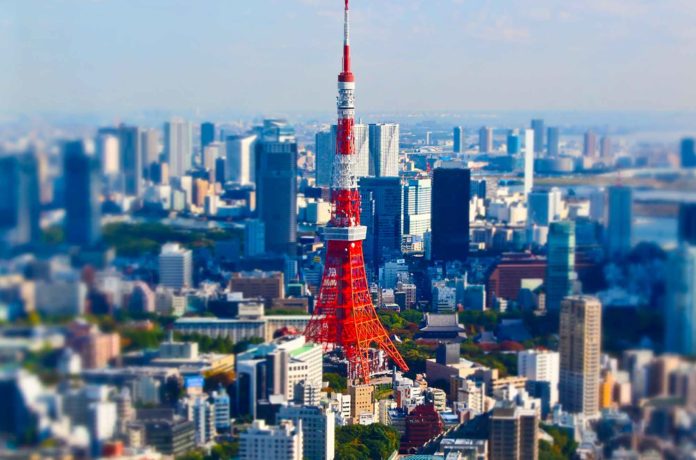Decades of low growth, population decline, and now a leading trend towards automated paper-free toilets … yet Japan through continuing long-term renewal of its tissue industry assets still registers increased, albeit slow, demand.

At 17kg consumed yearly per person, Japan’s tissue consumption rate leads all of Asia and is more like that of Western Europe and North America. Paradoxically, Japan also leads the world with the development and consumer acceptance of automated toilets that replace the need for toilet paper for cleaning. These appliances have become routine in upscale hotels and homes. It is possible that the Japanese tissue consumption rate could be even higher without the automated toilet systems.
Japan’s Tissue Mills range across its territory as shown in Figure 1. The growth of new capacity is shown in Figure 2 as the total count of tissue machines operating, under construction, or announced. The period from 2015 through 2018 saw an increase of over 70% of new tissue machines added as tissue companies in Japan built capacity to replace a portion of the tissue imports required to support consumption. More capacity is announced and under construction.
Japan’s economy has been suffering from low growth for decades, but it has recently improved. The blue bars in Figure 3 show the population slowly decreasing from 2007 to 2019. The population loss and overall aging has reduced consumer consumption, resulting in slower economic growth and lower total tissue demand. However, the plotted line shows strong growth in GDP per capita since 2009 that supports the ability of Japanese consumers to spend on tissue products such as paper towels.
Source: FisherSolve Next ©2020 Fisher International, Inc.
Inflation has been very low overall with some historic deflation as shown in the blue bars in Figure 4. More importantly, the plotted line in Figure 4 shows a large drop in unemployment since 2010. Taken together, these economic indicators support continued, but very slow, increases in tissue demand. This contrasts with the rapid buildup of new tissue machines seen in Figure 2. An examination of import and export volumes can shed further light on this matter. Figure 5 shows that Japan has relatively low exports versus the main customer countries. South Korea is the largest tissue customer. Other key customers include China, Philippines and Indonesia.
Figure 6 shows Japan’s tissue imports growing up to 2016 when the latest round of Japanese tissue capacity came online. Key tissue suppliers to Japan include China, Indonesia, Vietnam, and the United States.
Tissue imports are now outpacing exports by about 12X. Japan’s tissue companies have room to expand if their domestic production is competitive with these imports.
The country’s domestic tissue production is focused on consumer tissue products as shown in Figure 7. Commercial or AfH products make up a small percent of the total production. This probably indicates that the aging population is focused on at-home products and the imports could be significantly comprised of commercial products.
A further breakdown of tissue production is shown in Figure 8 with the finished tissue products produced. Despite Japan’s leadership in automated washing toilets, consumer bath tissue makes up most of its tissue production. Consumer facial tissue is the second most popular grade followed by consumer towels, indicating that Japan does not appear to have the consumer towel culture of North America.
Japan relies mostly on recovered paper for most of its tissue fibre as shown in Figure 9. Eucalyptus and Southern hardwood and softwood make up the rest of the fibre consumption. It produces no kraft pulp and a very small amount of sulfite pulp. Market recycled pulp is sold as bales and captive slurry systems.
Japanese tissue producers rely on mostly internally processed recycled fibre for the major finished products such as consumer bath, facial, and towel. The chart in Figure 10 shows that consumer napkin, tissue wrap stock, and absorbent liner production use mostly purchased pulps. However, some of these market pulps are from domestic recycled fibre producers.
Since most tissue production is consumer bath, this can be misleading as to where the volume of imported fibre is going versus the percentage makeup of smaller product types.
Figure 11 provides a view of purchased fibre type and volume by finished product. This analysis completes the view in Figure 10 to provide a comprehensive picture. Consumer facial and bath use most of the imported eucalyptus pulp.
The import and export data in Figures 5 and 6 suggest a comparison set for benchmarking Japan’s tissue manufacturing assets. China, Indonesia, Vietnam, South Korea, Turkey, and the United States all have tissue industries with regional or global impacts and are in the Japan trade data set. Please note that all the benchmark exercises that follow are based on the average of each country’s fleet of tissue machines. Some of the tissue fleets are very similar, while others have new and old assets.
Figure 12 shows Japan’s average tissue machine against the benchmark set averages, differentiated by the technical age of the machines and speed of operation. The size of the bubbles represents the relative size of each country’s tissue production. The Unites States and Japan have relatively old assets, and China, Indonesia, Turkey, and Vietnam are much newer. China, Vietnam, and Japan operate machines slower on average. Turkey, Indonesia, and the United States are in the top speed group. Another way of evaluating the tissue fleets would be a comparison on trim width. China would probably rank much lower with its numerous small machines.
Unlike the United States, Japan and the rest of the benchmark set do not have a measurable advanced tissue technology for wet texturing and structuring. Over 42% of the American fleet has some form of this technology and current projects and announcements will rapidly push this to 50%. This technology hasn’t made an impact in the Asian Pacific Region yet, except for Australia. China is reported to be experimenting with smaller home-build equipment. China, Indonesia, and Vietnam all are advantaged in average cost compared to Japan and the United States. If transportation costs were included, this difference would be magnified. Japan appears to have a much higher energy cost than all the others in the set, except for South Korea.
Figure 14 spotlights the comparison on energy costs and shows the magnitude of disadvantage in this metric experienced by Japan and South Korea.
The cash cost benchmarks provide a snapshot of the health of the country’s tissue industry. Figure 15 provides a three-five year future assessment using Fisher International’s Viability Benchmark that includes costs and compares the future investments required, company risk, along with other forward-looking factors to predict future completeness. Again, Japan and South Korea appear to be more at risk of replacement or being shut down by import pressure.
Carbon emissions per tonne of finished product are expected to become a larger factor in the cost and viability of operations and acceptance of imported products. Japan’s tissue assets are not significantly disadvantaged in this analysis. The United States has the highest level of emissions.
This is expected due to its unusually inexpensive energy and high percentage of advanced technology. The TAD process uses more energy per tonne of production but tends to produce higher performance at lower basis weights. That is not included in this analysis.
Japan is in the process of renewing its tissue assets with significant additions since 2015. These are expected to result in replacement of some of the older high-cost machines. Low-cost tissue imports from China and Indonesia will continue to compete based on lower cost manufacturing factors. The country is now growing its economy while continuing to age and lose population. Tissue consumption per capita will also grow slowly despite automated robotic toilets.
Analysis of competitive position requires specifics on tissue producers and individual machines. This article presents a static summary of Japan’s tissue industry today. Fibre prices, exchange rates, and environmental regulations will change, providing some participants with advantages and others with new challenges. The country’s tissue mills will continue to change hands and perhaps consolidate; neighbouring countries will likely invest in tissue-making capacity, thus affecting Japan’s imports and exports.
About Fisher International, Inc.
Fisher International, by virtue of its deep expertise in the pulp and paper industry, provides insights, intelligence, benchmarking, and modeling across myriad scenarios. By arming companies with the knowledge that will help them gain a better understanding of their strengths and help identify weaknesses, Fisher is helping businesses stave off challenges and better position themselves for long-term growth. For more information, visit www.fisheri.com, email [email protected] or call +1 203.854.5390 (USA)








































